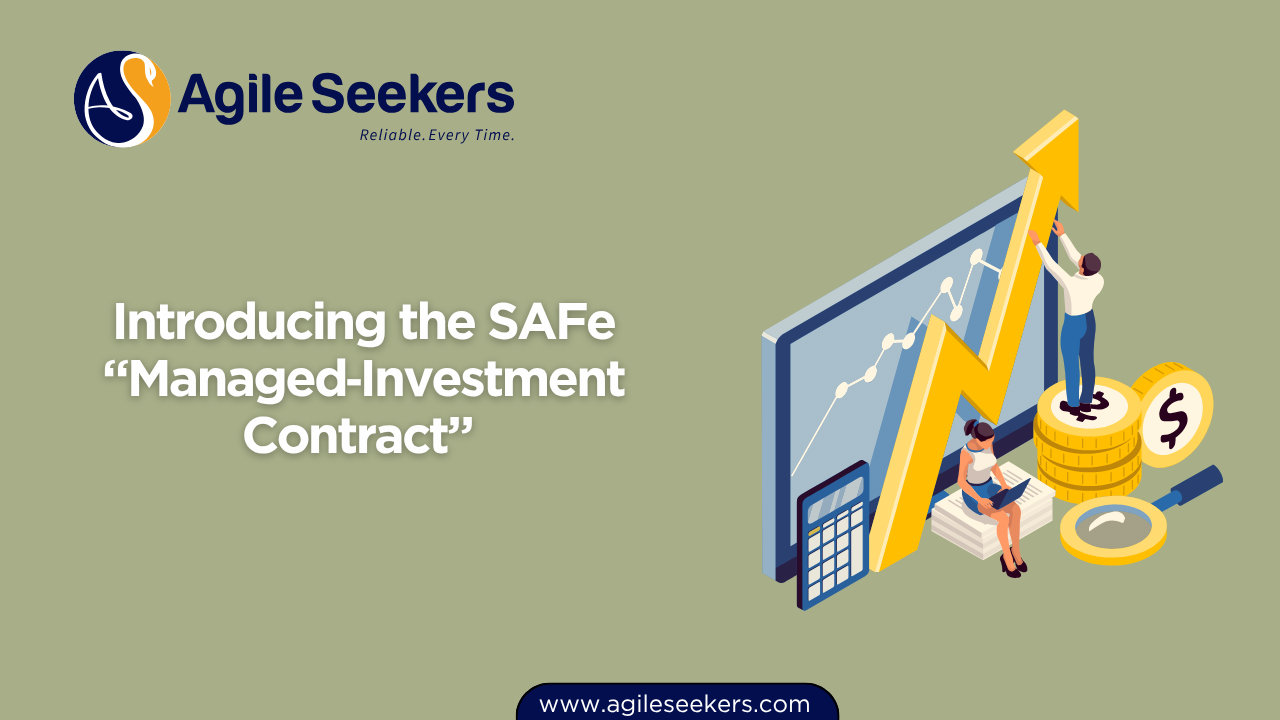Introducing the SAFe “Managed‑Investment Contract”

Traditional IT contracts often struggle to align with Agile delivery. Fixed-scope, fixed-price agreements emphasize upfront commitments and detailed requirements. But Agile thrives on adaptability, fast feedback, and continuous learning. Enter the SAFe® Managed-Investment Contract—a flexible, outcome-aligned approach to supplier engagement that supports the principles of Lean-Agile development.
This post unpacks the structure, core principles, and benefits of the Managed-Investment Contract and shows how it enables shared risk and reward between enterprises and vendors.
What Is the SAFe Managed-Investment Contract?
The Managed-Investment Contract is a recommended Agile contract structure in SAFe®, designed to support long-term, value-driven supplier relationships. Rather than locking both parties into a fixed scope or timeline, it defines a fixed investment over a defined timebox—typically aligned with Program Increments (PIs)—and expects delivery to evolve based on learning and priorities.
Instead of defining a rigid output, this contract structure:
- Aligns investment with business value
- Provides a mechanism for adaptive scope
- Encourages collaboration over compliance
- Builds in review and renegotiation checkpoints
This allows both parties to adjust to new insights and priorities, without constantly rewriting contracts.
Key Principles of a Managed-Investment Agile Contract
SAFe's contract model is built on the following Lean-Agile principles:
1. Fixed Time & Cost, Variable Scope
Rather than setting fixed deliverables, the investment defines a budget for a timeboxed period. The scope remains flexible, evolving through the collaborative discovery and planning process of each PI.
This principle supports SAFe’s focus on economic decision-making, aligning with practices taught in Leading SAFe Agilist certification training.
2. Incremental Value Delivery
Work is delivered in short iterations (Sprints) and grouped into PIs, allowing both vendor and client to inspect, adapt, and reprioritize frequently.
This reflects the role of the Product Owner/Product Manager in prioritizing value delivery, a core skill covered in SAFe POPM certification.
3. Built-in Learning and Adjustments
Rather than front-loading all requirements, learning is built into the process. If insights emerge during delivery, the scope can adapt—without the change control burdens typical in traditional contracts.
4. Joint Risk Management
The contract framework ensures both the supplier and buyer share risks and rewards. Since the scope is dynamic, the supplier isn’t penalized for changes. Instead, performance is evaluated based on value delivery, quality, and team collaboration.
5. Governance Through Lean Portfolio Management
Progress is governed by ongoing alignment with epics, outcomes, and strategic themes—often managed via Lean Portfolio Management practices.
Professionals trained through SAFe Release Train Engineer Certification play a vital role in ensuring coordination between execution and strategy.
Contract Structure: How It Works
| Component | Details |
|---|---|
| Investment Commitment | A defined budget allocated per quarter or PI (e.g., ₹50 lakhs per PI). |
| Delivery Cadence | Teams deliver incrementally every Sprint and commit at PI Planning. |
| Scope Planning | Initial high-level epics or features, refined iteratively. |
| Governance | Regular demos, Inspect & Adapt workshops, economic evaluation. |
| Exit/Review Points | Scheduled checkpoints to renew, revise, or exit the contract. |
Benefits of Managed-Investment Contracts
- Enables Agility While Controlling Costs
By fixing the investment, enterprises can manage financial exposure while still getting the flexibility to adjust scope as understanding evolves. - Drives Value-Based Delivery
Teams prioritize customer-centric outcomes over feature checklists. This aligns well with the SAFe focus on rapid feedback loops.
These are foundational elements for teams led by SAFe Scrum Masters. Learn more in the SAFe Scrum Master certification. - Encourages Collaboration
Vendors and enterprises act as partners, not adversaries. Instead of negotiating every change request, they collaborate continuously through PIs and Sprints. - Reduces Waste
Traditional contracts often lead to wasted time on documentation, rework, or disputes. This model reduces that by focusing on lean governance and continuous value flow.
This supports principles covered in SAFe Advanced Scrum Master training. - Builds Long-Term Relationships
With shared success metrics and flexible scope, enterprises and vendors are encouraged to co-invest in innovation rather than negotiate for control.
How It Aligns with Lean-Agile Principles
The Managed-Investment Contract is not just a legal framework—it’s a strategic enabler of agility. It maps directly to several SAFe Lean-Agile principles:
- Apply systems thinking
- Assume variability, preserve options
- Build incrementally with fast feedback
- Decentralize decision-making
SAFe guidance encourages organizations to pair this contract model with Agile budgeting, value streams, and solution trains—topics often mastered by experienced RTEs.
Considerations When Using a Managed-Investment Contract
Before adopting this contract model, enterprises should ensure:
- There is maturity in Agile delivery and planning across teams
- A robust Agile Release Train (ART) structure is in place
- Program Increment planning and demos are consistently practiced
- Both vendor and client understand Agile contracting principles
Additionally, legal and procurement teams may need exposure to Agile contract strategies. A useful reference is this HBR article on Agile contracts.
Final Thoughts
The SAFe Managed-Investment Contract represents a shift from rigid, control-based contracts to adaptive, value-driven partnerships. By fixing cost and time—but allowing scope to evolve—it enables organizations to balance flexibility with financial accountability. This model supports the essence of SAFe: delivering value early, often, and collaboratively.
Organizations adopting Agile at scale can benefit significantly from this contract—especially when aligning with Lean Portfolio Management and value stream strategies.
To contribute effectively in such Agile environments, professionals can upskill through Leading SAFe, SAFe POPM, or SAFe Scrum Master certification.
Also read - Why Traditional Fixed‑Price Contracts Fail in Agile Environments?
Also see - Agile Procurement: Moving Beyond Time & Materials Contracts




















